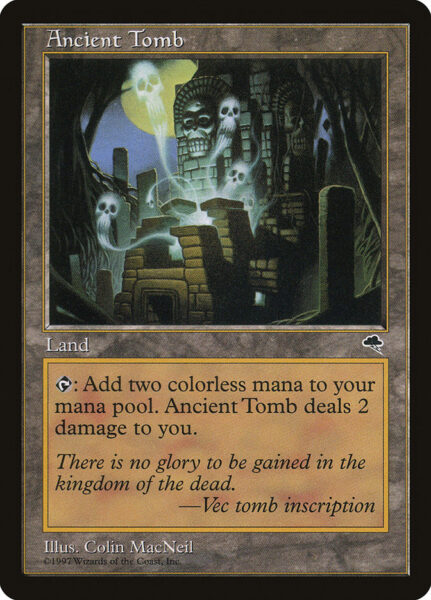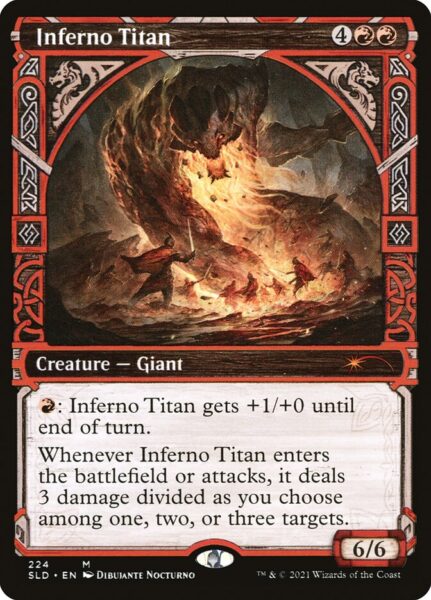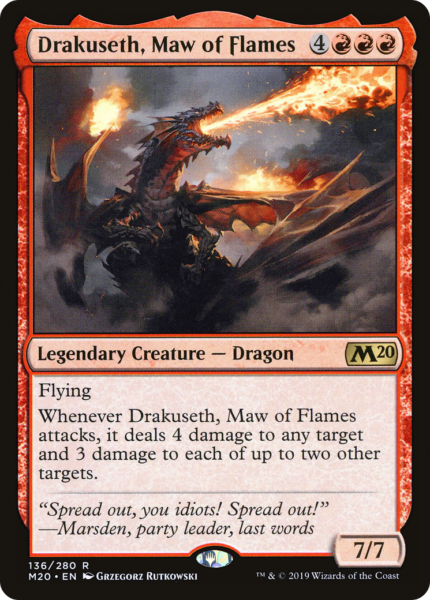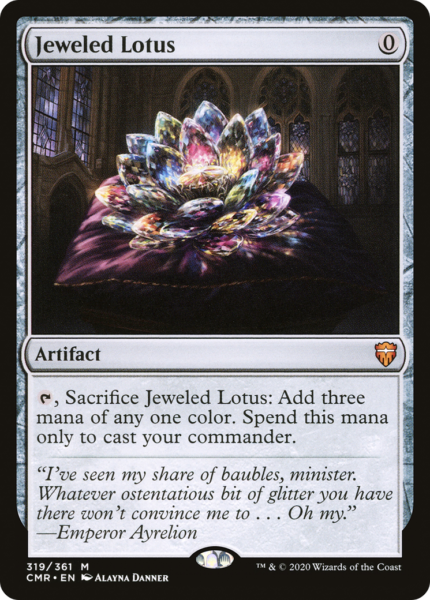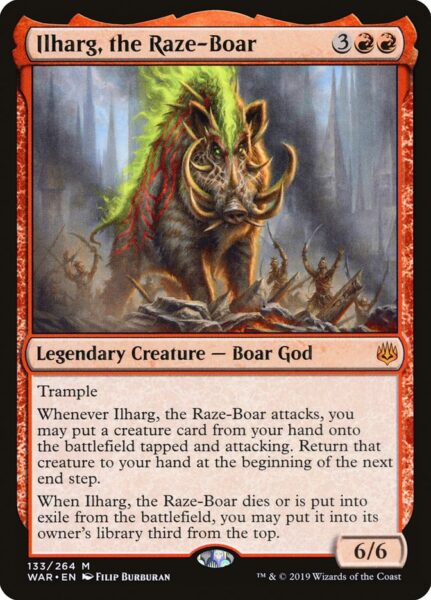by Johnny Cycles, August 28th, 2023
Purphoros, Bronze-Blooded gives us Sneak Attack on a commander. But this deck doesn’t just want to cheat big fatties into play; it wants to abuse Purphoros’ ability by avoiding the sacrifice part of the text. We even have the ability to 1-shot our opponent as early as turn 1.
Decklist – Mono Red with Purphoros, Bronze-Blooded
| Purphoros, Bronze-Blooded |
Creatures (27)
| Dockside Extortionist |
| Feldon of the Third Path | |
| Goblin Chainwhirler | |
| Seasoned Pyromancer | |
| Atsushi, the Blazing Sky | |
| Pia and Kiran Nalaar | |
| Solemn Simulacrum | |
| Torbran, Thane of Red Fell | |
| Ilharg, the Raze-Boar | |
| Ox of Agonas |
| Hellkite Tyrant | |
| Inferno Titan | |
| Steel Hellkite | |
| Balefire Dragon | |
| Drakuseth, Maw of Flames | |
| Meteor Golem | |
| Spawn of Thraxes | |
| Terror of Mount Velus | |
| Tyrant’s Familiar |
| Bogardan Hellkite | |
| Cityscape Leveler | |
| Utvara Hellkite | |
| Blast-Furnace Hellkite | |
| Phyrexian Triniform | |
| Triplicate Titan | |
| Ancient Stone Idol | |
| Blightsteel Colossus |
Planeswalkers (4)
| Jeska, Thrice Reborn | |
| Chandra, Torch of Defiance | |
| Karn, Scion of Urza | |
| Ugin, the Ineffable |
Artifacts (18)
| Chrome Mox | |
| Jeweled Lotus | |
| Mana Crypt | |
| Expedition Map | |
| Mana Vault | |
| Manifold Key | |
| Arcane Signet | |
| Fellwar Stone | |
| Ruby Medallion | |
| Sundial of the Infinite |
| Mimic Vat | |
| Mirage Mirror | |
| Quicksilver Amulet | |
| The One Ring | |
| Cauldron of Souls | |
| Conjurer’s Closet | |
| Dollhouse of Horrors | |
| Mirrorworks |
Enchantments (7)
| Spiteful Banditry | |
| Blood Moon | |
| Fable of the Mirror-Breaker | |
| Descendants’ Fury | |
| Industrial Advancement | |
| Sneak Attack | |
| Possibility Storm |
Instants (4)
| Wild Magic Surge | |
| Chaos Warp | |
| Valakut Awakening | |
| Savage Beating |
Sorceries (3)
| Jeska’s Will | |
| Star of Extinction | |
| Blasphemous Act |
Lands (36)
| Wasteland | |
| Mountain (24) |
Deck Tech
Primary Game Plan
No secret here… Purphoros, Bronze-Blooded incentivizes us to cheat big fatties into play and hit hard and fast. The obvious problem with this is that we will quickly run out of powerful creatures since we have to sacrifice them at the beginning of our next end step, leaving us at the mercy of the top of our deck. With this in mind, our game plan isn’t as straightforward as it at first seems. Rather than cheat our bombs into play as early as possible, we want to be strategic about when we use Purphoros, Bronze-Blooded‘s ability, particularly in the early game. We more often than not only cheat a creature into play when we need to answer a threat or problematic permanent, while we set up for the mid- to late-game. Once we’ve stabilized, we either want to hard cast our bombs, taking advantage of the haste Purphoros, Bronze-Blooded‘s static ability gives our creatures, or cheat multiple big threats onto the battlefield at once to kill our opponent in one attack. With the latter plan in mind, we will have ideally found one of our support cards that will allow us to avoid sacrificing the creatures we cheated into play.
With this plan in mind, the deck can be divided into a few key parts. First, we play some of the best and most powerful mana rocks in the game. These mana rocks advance both parts of our game plan. They let us cast our commander as early as turn 1 to begin cheating in our bombs when necessary to survive the early game, and they ramp us into hard-casting our bombs in the mid- to late-game, well ahead of the curve.
Still no Sol Ring? If you don’t stand for something, you’ll fall for anything…
The second key part of the deck is the bombs, the big fatties, the creatures that hit hard, while also doing something else, either when they enter the battlefield, attack, or deal combat damage. These creatures also serve a dual purpose. First, we cheat them into play early to clear the board of our opponent’s creatures and/or other nonland permanents that are causing us issues, while hopefully chipping in some early damage. Second, once we’ve stabilized, we hard cast them to take over the game.
The third key part of this deck is the support cards that allow us to get around the sacrifice clause of Purphoros, Bronze-Blooded. After all, if we are only getting a single use out of our bombs, we aren’t playing this deck optimally. We are looking either to bring the sacrificed creatures back (from the graveyard or otherwise), make copies of them, or replace them with a bomb that we won’t have to sacrifice. And all of this isn’t even mentioning the many creatures we play with death triggers that leave a body (or bodies) behind.
The remainder of the deck is filled out with some sweepers, card draw, and value creatures we can cast in the early game, either to help us stabilize (Goblin Chainwhirler) or advance our game plan (Solemn Simulacrum).
How to Get the Most Out of Purphoros, Bronze-Blooded
First, we use creatures with enter-the-battlefield (ETB), combat, or damage triggers. They will still die at the end step, but they will have provided us with value beyond lowering our opponent’s life total.
ETB Effects
Bogardan Hellkite – 5 damage to up to 5 targets is extremely flexible and can help stabilize the board long enough to get our other threats online.
Inferno Titan – another way to clean up little creatures or deal with one big one, particularly as it has an attack trigger that will give us a total of 6 points of damage to distribute as we see fit if we’ve cheated it in.
Meteor Golem – provides us with a flexible answer to whatever ails us.
Spawn of Thraxes – often not at its best on turn 3, it can still take care of any number of pesky creatures early. Late game, it can kill a bigger threat or provide that extra bit of damage to win the game.
Terror of Mount Velus – giving our team double strike can end a game in one swing.
Attack Triggers
Blast-Furnace Hellkite – giving our team double strike seems pretty good…wait, didn’t I just say this?
Cityscape Leveler – great at answering our problem cards (see below) or just our opponent’s best creature.
Drakuseth, Maw of Flames – killing three targets is great value.
Inferno Titan – the three damage among three targets is on the attack trigger as well.
Tyrant’s Familiar – since we want to cheat this into play, it will more often than not be a 7/7, but that’s not really our main goal. As with the ETB triggers on creatures like Bogardan Hellkite, we are more interested in killing off big threats.
Utvara Hellkite – if we cheat him in, we get the 6/6 Dragon creature token after his attack. If we don’t, then we are probably winning. Combine this ability with the other dragons in the deck, and this 8-drop can end a game on the spot.
Combat Damage Triggers
Balefire Dragon – 6 damage to each creature will more often than not be a 1-sided board wipe.
Hellkite Tyrant – stealing other people’s artifacts is a powerful effect, even if we don’t get close to the twenty needed to win the game. However, having a card that says, “you win the game” is nothing to sneeze at and we play plenty of artifacts, given our need to ramp and Purphoros, Bronze-Blooded’s text.
Steel Hellkite – another way to destroy both problematic enchantments and anything else that might be bothering us.
Death Triggers
Ancient Stone Idol – this card is weird, but awesome. Why trample isn’t after flash, I have no idea. It has an alternate way of cheating it in, but most importantly, it leaves behind a relevant body.
Phyrexian Triniform – three 3/3 bodies that add to our artifact count is an acceptable price for 3 mana, attack for 9. That we can bring it back eventually from the graveyard is an added bonus.
Triplicate Titan – similar to Phyrexian Triniform, we get three 3/3 artifact bodies, this time with an additional keyword for each.
Many of the above cards serve as removal on a large body and are costed appropriately. However, by cheating them in, we can use their various abilities to stabilize, as well as get in some damage that will make our late game plays, when we will have the option of hard casting the big fatties, that much more deadly. And since the deck doesn’t run a lot of cheap removal, these creatures are often our only way of dealing with must-kill commanders and threats.
Cheating the above creatures into play with Purphoros, Bronze-Blooded’s ability is playing him fairly. So, how do we abuse him?
End the Turn
Sundial of the Infinite – with the sacrifice trigger on the stack, use Sundial of the Infinite’s ability and we get to keep our Utvara Hellkite or Balefire Dragon that we played for 3 mana. Yes, please!
Copies
Mimic Vat – so much complicated text on this one, but it’s worth understanding how it works. It is essentially a repeatable way to make a token of a creature (any creature) that has died. Here’s how it works. The first time a nontoken creature dies, we may exile it with Mimic Vat. After that, we can pay 3, tap this artifact, and make a token copy of the exiled card that will itself be exiled at the next end step. We can do this as long as there is a card exiled with Mimic Vat. Furthermore, we can do this as many times as we are able to untap Mimic Vat (once more using our Manifold Key) and have the mana to pay for its ability.
The catch is we can only have one creature exiled with Mimic Vat at a time. If multiple creatures hit the graveyard at the same time, we pick the one we want to exile. Two things are worth highlighting. First, since it’s a may ability, we don’t have to exile a nontoken creature when it dies. It is our choice. However, when we do so, we return the current exiled creature to its owner’s graveyard. This allows us to keep a more powerful creature that has died and been exiled over a weaker creature that dies later in the game, or to upgrade to a more powerful creature that dies after the first one we’ve exiled.
Second, we can exile any nontoken creature that dies, not just those we control. This can be particularly useful as a way to prevent reanimation shenanigans or simply to steal our opponent’s best creature from the graveyard.
Here’s an example of how we want Mimic Vat to work in the deck. We cheat in Inferno Titan with Purphoros, Bronze-Blooded. When it dies at our end step, we exile it with Mimic Vat. Now we can create a token on our next turn for 3 mana, get all the fun ETB and attack triggers, not to mention hitting for at least 6, and then do it all again the turn after.
Mirage Mirror – not nearly as complicated or as powerful as Mimic Vat, Mirage Mirror can become a copy of a big fatty we have cheated into play. Since our commander gives creatures haste, this allows us to double up our attack. It’s worth nothing that we won’t get the ETB triggers, though attack and combat triggers will still happen.
Mirrorworks – allows us to pay 2 to copy one of our artifacts. We can cheat an artifact creature into play and use Mirrorworks to make a token of it, so that when we sacrifice the original at the end step, we are left with a slightly worse version of it. It also allows us to double up ETB effects. Want Meteor Golem’s effect twice? Yes! It can also be used with other artifacts. Want two copies of Mana Crypt? Who wouldn’t?
Reflection of Kiki-Jiki – the flip side of Fable of the Mirror-Breaker, we can copy one of the creatures we cheat in and get double the value!
Avoid the Trigger
Chaos Warp – also in our deck to deal with otherwise hard-to-answer cards from our opponents, we can role the dice and hope to trade up, while also putting our big fatty back in our deck to draw later.
Conjurer’s Closet – arguably our best card to abuse Purphoros, Bronze-Blooded’s ability, Conjurer’s Closet allows us to stack our triggers to not only keep our big fatty around, but to get its ETB effect a second time. Now that’s living the dream!
Descendants’ Fury – not as good as Conjurer’s Closet, this is one of two recently printed enchantments that allow us to replace the creature we cheated in before our end step, assuming we deal combat damage with it. We are guaranteed to find a creature, unlike the other new enchantment, which is…
Industrial Advancement – gives us the chance to trade up on a creature we were going to have to sacrifice anyway. We can potentially turn our Inferno Titan into a Blightsteel Colossus. It also gives us a sacrifice outlet if we want to trigger our own Solemn Simulacrum or Atsushi, the Blazing Sky.
Eff the Trigger
Cauldron of Souls – let the big fatty die and have it come back with a -1/-1 counter. It’s a win-win, as we get all the fun triggers a second time that turn, while also getting to keep our creature.
Quicksilver Amulet – for just one more mana, we get to cheat a creature into play without the sacrifice clause.
Bring Them Back From the Graveyard
Dollhouse of Horrors – a 1-time use that gives us the ETB and other triggers at the cost of power and toughness, though with enough Constructs from other sources out, the token could end up being bigger than the original. The benefit of Dollhouse of Horrors over something like Mimic Vat is that the token sticks around for just a single mana.
Feldon of the Third Path – is our best reanimation card, as it can target any creature card in our graveyard, regardless of when it was put there. The token he creates is sacrificed, but this, too, is a plus. Want three 3/3 golems every turn while also attacking for 9? Let’s reanimate Phyrexian Triniform every turn for three mana! How about fetching up a basic while drawing a card every turn? Thank you Solemn Simulacrum! The fact that Feldon of the Third Path can target any of our creatures and not just artifacts is both a flavor win and extreme value.
Just Kill Your Opponent on Turn One
The click-bait that got you reading is finally answered! By now, you’ve probably already figured it out, but here’s the hand we need for a turn 1 kill:
Mana Crypt, Jeweled Lotus, Mana Vault, Mountain, Blightsteel Colossus…and that’s only 5 out of 7 cards!
Play Mana Crypt and tap it to play Mana Vault. We have four mana available now. Play Jeweled Lotus and our Mountain. Sacrifice Jeweled Lotus and spend two of our floating colorless mana to cast Purphoros, Bronze-Blooded. Tap our Mountain and spend the remaining two colorless mana to cheat in Blightsteel Colossus and hope our opponent doesn’t have Solitude!
Back-Up Plan
Like any good deck, we need a back-up plan in case our opponent answers our Purphoros, Bronze-Blooded or hates out our main game plan with Authority of the Consuls or a similar effect.
Mana rocks
Not the most powerful back-up plan, but when half of your creatures are bombs, casting them ahead-of-curve can be extremely powerful. With 8 mana rocks, including some of the best available, this plan is fairly reliable. (For when I include the expensive mana rocks and why I don’t play Sol Ring, see my introductory article to Commander.)
Damage Increasing Effects
This is more support than an alternate win condition, but we play a couple of ways to increase the damage we do with our creatures.
Jeska, Thrice Reborn – Fiery Emancipation on a Planeswalker, tripling the damage from one of our big creatures can be back-breaking, if not game-ending. She can also pick off pesky creatures in the right situation. This, coupled with a cheaper mana cost, is why she made the cut over the 6-drop enchantment.
Savage Beating – extra combat spells is another direction this deck can go and with the recent reprinting of this old rare from Darksteel in Commander Masters, I’m trying it out. The flexibility the spell gives us in choosing double strike, an extra combat step, or both, make it a powerful finisher.
Torbran, Thane of Red Fell – besides the extra 2 points of damage, Tobran adds 3 to our devotion to make Purphoros, Bronze-Blooded a creature. He’s also an on-curve threat that, if left unanswered, can help us run away with a game.
Artifacts
We play 26 total artifacts (including creatures), with a handful of other ways to produce more (Spiteful Banditry is a new addition). While not an alternate win condition by itself, it does give us a legitimate chance at winning with Hellkite Tyrant, while furthering our main game plan. The bonus all our artifacts gives to our Constructs is also relevant.
Purphoros, Bronze-Blooded 2.0
When our main game plan is derailed by Pithing Needle or Frogify, we have a few alternative means of sneaking our bombs into play.
Ilharg, the Raze-Boar – this legendary Boar God is a powerful alternative at the commander slot and makes for a very effective alternate game plan in the right situation. The main issue with Ilharg, the Raze-Boar is that the hate that shuts down Purphoros, Bronze-Blooded, nullifies Ilharg as well. Still, the fact that we return the creature we cheat into play to our hand is an obvious upgrade to sacrificing it in nearly every case. Ilharg, the Raze-Boar has to survive combat, however, for us to get repeat value out of him.
Sneak Attack – Everything Purphoros does for one .
Hate for the Hate
Cards that make our creatures enter the battlefield tapped, like Authority of the Consuls and Blind Obedience, ruin our fun, while also being enchantments, which are particularly difficult for red to deal with. We need answers or we often just lose, particularly as these cards can come down as early as turn 1.
Blast Zone – a way to deal with enchantments, or other problematic non-land permanents.
Chaos Warp – what are the chances our opponent will spin into something worse than Blind Obedience? As long as it’s not Authority of the Consuls, we should be okay.
Cityscape Leveler – a powerful recursive threat that gives us an answer to our problem cards…a perfect fit!
Meteor Golem – a worse Cityscape Leveler, but does what we need.
Ugin, the Ineffable – not only gives us answers, but it also reduces the cost of our artifact creatures, and that’s not nothing.
Wild Magic Surge – chances are greater our opponent spins into Authority of the Consuls from Blind Obedience than with Chaos Warp, but it’s worth the risk.
The Spice
Possibility Storm – is always a fun card, but it does work in a deck like this. Once we have our commander out, we can cheat our threats into play, thereby avoiding Possibility Storm’s trigger, while our opponents will be left hoping. We can also choose to cast some of our smaller creatures to try for an upgrade. Goblin Chainwhirler becomes Balefire Dragon? Yes! Arcane Signet becomes Blightsteel Colossus? Double yes!
Flex Spots
There are plenty of red and artifact creatures you can play instead of those in this list, though many of the ones here are the best at what this deck is trying to do. Of the ones not already highlighted, Seasoned Pyromancer and Ox of Agonas help alleviate flood, while Pia and Kiran Nalaar synergize in more ways than one. Goblin Chainwhirler gets rid of pesky tokens and mana dorks, while also blocking well and adding to our devotion.
The rest of the deck is mostly a few board wipes, card draw, and some cards that do more than one thing, depending on our needs. Blood Moon is too good to pass up in a deck like this, as we lack the kind of interaction other colors provide. This 3-mana enchantment can slow our opponent down or simply stop them from executing their gameplan long enough for us to execute ours. Jeska’s Will can give us an early, busted turn or dig for what we’re lacking in the late-game. Chandra, Torch of Defiance gives us some spot removal, card draw, and ramp, with an ultimate that can win the game, while Karn, Scion of Urza provides card draw and threats that can be massive, given how many artifacts we play.
A case could be made for Crucible of Worlds, as recurring Urza’s Saga or our land destruction can be game-changing, but I don’t think this is the deck it’s best in.
Here’s a list of cards that didn’t make the cut but maybe should in your meta:
Myr Battlesphere was a tough cut to make. The card synergizes with both our Purphoros, Bronze-Blooded game plan, and with our win by making a bunch of artifacts game plan. Honestly, in all the games I’ve played with this deck, I’ve neither cast, nor cheated the powerful artifact creature into play a single time. With power creep and nearly every set feeling like it’s made for Commander, I finally made the hard choice to cut it for more powerful threats (Cityscape Leveler, for instance).
Ideal Hand and Game Play
Other than your turn 1 kill, your ideal hand will have 2-3 lands, at least 1 mana rock, 1-2 big fatties, and something to cast on turns 2, 3, or 4, whether it be a card draw spell, one of our creatures along the curve, or an artifact that allows us to abuse Purphoros, Bronze-Blooded.
I recommend being careful with cheating in your big creatures too early and often if you will be living from the top of your deck afterwards. Without a way to copy them or recur them, they often hit once and that’s it. Obviously, the board state will dictate when is best to deploy them on the cheap and when to wait until you can hard cast them, but don’t make the mistake of cheating threats into play early just because you can, particularly in a 4-person game.
A common line of play is to cheat in one of our creatures that can answer our opponent’s best threat or that can functionally wipe the board so as to buy us the time we need to make our land drops and start hard casting our bombs. If we are able to manage the board state with our smaller creatures, this is ideal, as we can then save our big bombs for when we can hard cast them or cheat multiple ones in for the kill. Don’t forget that we can use Purphoros, Bronze-Blooded‘s ability at instant speed, which means we can sneak in a blocker if necessary.
Weaknesses
Mana flood is a common occurrence in a deck that wants to hard cast 7- and 8-drops, since cheating our threats into play is not a long-term winning strategy if we have no way to abuse the ability. As mentioned, cards that cause our creatures to enter the battlefield tapped shut down our commander’s ability. And while it’s true we don’t often want to cheat in a single creature on turn 3 or 4, we do want to be able to cheat in 2 or 3 creatures on turn 7 or 8 to go for the kill. Cards like Blind Obedience make this impossible.
Conclusion
The deck is super fun and has some extremely powerful draws. The risk of durdling is real, but the busted things the deck can do make it worth it. If you find yourself flooding too much, you can always trim a land or add a card-draw spell or two. Faithless Looting and the like have been in previous iterations of this deck and help with clunky draws. I think potential upgrades could be in the direction of extra combat spells, of which red has several good options.
What other ways can you think of to abuse Purphoros, Bronze-Blooded? What big fatty am I forgetting? Post your thoughts in the comments below and thanks for reading!



